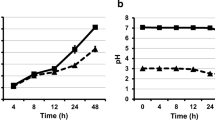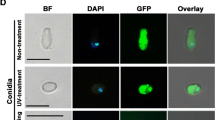Abstract
In the present manuscript, we describe the mechanisms involved in the yeast-to-hypha dimorphic transition of the plant pathogenic Basidiomycota fungus Ustilago maydis. During its life cycle, U. maydis presents two stages: one in the form of haploid saprophytic yeasts that divide by budding and the other that is the product of the mating of sexually compatible yeast cells (sporidia), in the form of mycelial dikaryons that invade the plant host. The occurrence of the involved dimorphic transition is controlled by the two mating loci a and b. In addition, the dimorphic event can be obtained in vitro by different stimuli: change in the pH of the growth medium, use of different carbon sources, and by nitrogen depletion. The presence of other factors and mechanisms may affect this phenomenon; among these, we may cite the PKA and MAPK signal transduction pathways, polyamines, and factors that affect the structure of the nucleosomes. Some of these factors and conditions may affect all these dimorphic events, or they may be specific for only one or more but not all the processes involved. The conclusion reached by these experiments is that U. maydis has constituted a useful model for the analysis of the mechanisms involved in cell differentiation of fungi in general.

Similar content being viewed by others
References
Aréchiga-Carvajal ET, Ruiz-Herrera J (2005) The RIM101/pacC homologue from the Basidiomycete Ustilago maydis is functional in multiple pH-sensitive phenomena. Eukaryot Cell 4:999–1008
Banuett F (2002) Pathogenic development in Ustilago maydis. In: Osiewacz HD (ed) Molecular biology of fungal development. CRC Press, New York, pp 349–398
Banuett F, Herskowits I (1994) Identification of Fuz7, a Ustilago maydis MEK/MAPKK homolog required for a-locus-dependent and -independent steps in the fungal life cycle. Genes Dev 8:1367–1378
Barret KJ, Gold SE, Kronstad JW (1993) Identification and complementation of a mutation to a constitutive filamentous growth in Ustilago maydis. Mol Plant-Microbe Interact 6:274–283
Bölker M, Urban M, Kahmann R (1992) The a mating type locus of U. maydis specifies cell signaling components. Cell 68:441–450
Brefort T, Doehlemann G, Mendoza-Mendoza A et al (2009) Ustilago maydis as a pathogen. Annu Rev Phytopathol 47:423–445
Cano-Canchola C, Sosa L, Fonzi W, Sypherd P, Ruiz-Herrera J (1992) Developmental regulation of CUP gene expression through methylation in Mucor spp. J Bacteriol 174:362–366
Christenssen JJ (1963) Corn smut caused by Ustilago maydis. Am Phytopathol Soc Monogr 2:1–41
Elías-Villalobos A, Fernández-Álvarez A, Moreno-Sánchez I, Helmlinger D, Ibeas JI (2015) The Hos2 histone deacetylase controls Ustilago maydis virulence through direct regulation of mating-type genes. PLOS Path 11(8):e1005134. https://doi.org/10.1371/journal.ppat.1005134
Froeliger EH, Leong SA (1991) The a mating type genes of Ustilago maydis are idiomorphs. Gene 100:113–122. https://doi.org/10.1016/0378-1119(91)90356-g
Gevrekci AO (2017) The roles of polyamines in microorganisms. World J Microbiol Biotechnol 33:1–7. https://doi.org/10.1007/s11274-017-2370-y
Gold S, Duncan G, Barrett K, Kronstad J (1994) cAMP regulates morphogenesis in the fungal pathogen Ustilago maydis. Genes Dev 8:2805–2816. https://doi.org/10.1101/gad.8.23.2805
González-Prieto JM, Rosas-Quijano R, Domínguez A, Ruiz-Herrera J (2014) The UmGcn5 gene encoding histone acetyltransferase from Ustilago maydis is involved in dimorphism and virulence. Fungal Genet Biol 71:86–95. https://doi.org/10.1016/j.fgb.2014.09.002
Guevara-Olvera L, Xoconostle-Cázares B, Ruiz-Herrera J (1997) Cloning and disruption of the ornithine decarboxylase gene of Ustilago maydis: evidence for a role of polyamines in its dimorphic transition. Microbiology 143:2237–2245. https://doi.org/10.1099/00221287-143-7-2237
Han X, Altegoer F, Steinchen W, Binnebesel L, Schuhmacher J, Glatter T, Giammarinaro PI, Djamei A, Rensing SA, Reissmann S, Kahmann R, Bange G (2019) A kiwellin disarms the metabolic activity of a secreted fungal virulence factor. Nature 565:650–653. https://doi.org/10.1038/s41586-018-0857-9
Kämper J, Kahmann R, Bölker M, Ma LJ, Brefort T, Saville BJ, Banuett F, Kronstad JW, Gold SE, Müller O, Perlin MH, Wösten HA, de Vries R, Ruiz-Herrera J, Reynaga-Peña CG, Snetselaar K, McCann M, Pérez-Martín J, Feldbrügge M, Basse CW, Steinberg G, Ibeas JI, Holloman W, Guzman P, Farman M, Stajich JE, Sentandreu R, González-Prieto JM, Kennell JC, Molina L, Schirawski J, Mendoza-Mendoza A, Greilinger D, Münch K, Rössel N, Scherer M, Vranes M, Ladendorf O, Vincon V, Fuchs U, Sandrock B, Meng S, Ho EC, Cahill MJ, Boyce KJ, Klose J, Klosterman SJ, Deelstra HJ, Ortiz-Castellanos L, Li W, Sanchez-Alonso P, Schreier PH, Häuser-Hahn I, Vaupel M, Koopmann E, Friedrich G, Voss H, Schlüter T, Margolis J, Platt D, Swimmer C, Gnirke A, Chen F, Vysotskaia V, Mannhaupt G, Güldener U, Münsterkötter M, Haase D, Oesterheld M, Mewes HW, Mauceli EW, DeCaprio D, Wade CM, Butler J, Young S, Jaffe DB, Calvo S, Nusbaum C, Galagan J, Birren BW (2006) Insights of the genome of the biotrophic fungal plant pathogen Ustilago maydis. Nature 444:97–101. https://doi.org/10.1038/nature05248
Klose J, Moniz de Sá MM, Kronstad JW (2004) Lipid-induced filamentous growth in Ustilago maydis. Mol Microbiol 52:823–835. https://doi.org/10.1111/j.1365-2958.2004.04019.x
Klosterman SJ, Perlin MH, Garcia-Pedrajas M, Covert SF, Gold SE (2007) Genetics of morphogenesis and pathogenic development of Ustilago maydis. Adv Genet 57:1–47. https://doi.org/10.1016/S0065-2660(06)57001-4
Kretschmer M, Lambie S, Croll D, Kronstad JW (2018) Acetate provokes mitochondrial stress and cell death in Ustilago maydis. Mol Microbiol 107:488–507. https://doi.org/10.1111/mmi.13894
Lanver D, Müller AN, Happe P et al (2018) The biotrophic development of Ustilago maydis studied by RNA-Seq analysis. Plant Cell 30:300–323. https://doi.org/10.1111/mmi.13894
Martínez-Espinoza AD, León C, Elizarraraz G, Ruiz-Herrera J (1997) Monomorphic nonpathogenic mutants of Ustilago maydis. Phytopathology 87:259–265. https://doi.org/10.1094/PHYTO.1997.87.3.259
Martínez-Espinoza AD, Ruiz-Herrera J, León-Ramírez CG, Gold SE (2004) MAP kinase and cAMP signaling pathways modulate the pH-induced yeast-to-mycelium dimorphic transition in the corn smut fungus Ustilago maydis. Curr Microbiol 49:274–281. https://doi.org/10.1007/s00284-004-4315-6
Martínez-Soto D, Ruiz-Herrera J (2013) Transcriptomic analysis of the dimorphic transition of Ustilago maydis induced in vitro by a change in pH. Fungal Genet Biol 58:116–125. https://doi.org/10.1016/j.fgb.2013.08.011
Martínez-Soto D, Ruiz-Herrera J (2015) Regulation of the expression of the whole genome of Ustilago maydis by a MAPK pathway. Arch Microbiol 197:575–588. https://doi.org/10.1007/s00203-015-1087-2
Martínez-Soto D, González-Prieto JM, Ruiz-Herrera J (2015) Transcriptomic analysis of the GCN5 gene reveals mechanisms of the epigenetic regulation of virulence and morphogenesis in Ustilago maydis. FEMS Yeast Res 15:fov055. https://doi.org/10.1093/femsyr/fov055
Puhalla JE (1970) Genetic studies of the b incompatibility locus of Ustilago maydis. Genet Res Camb 16:229–232. https://doi.org/10.1017/S0016672300002457
Reyna-López GE, Ruiz-Herrera J (2004) Specificity of DNA methylation changes during fungal dimorphism and its relationship to polyamines. Curr Microbiol 48:118–123. https://doi.org/10.1007/s00284-003-4142-1
Reyna-López GE, Simpson J, Ruiz-Herrera J (1997) Differences in DNA methylation patterns are detectable during the dimorphic transition of fungi by amplification of restriction polymorphisms. Mol Gen Genet 253:703–710. https://doi.org/10.1007/s004380050374
Rocha RO, Wilson RA (2019) Essential, deadly, enigmatic: polyamine metabolism and roles in fungal cells. Fungal Biol Rev 33:47–57. https://doi.org/10.1016/j.fbr.2018.07.003
Ruiz-Herrera J, León-Ramírez C, Guevara-Olvera L, Cárabez-Trejo A (1995a) Yeast-mycelial dimorphism of haploid and diploid strains of Ustilago maydis. Microbiology 141:695–703. https://doi.org/10.1099/13500872-141-3-695
Ruiz-Herrera J, Ruiz-Medrano R, Domínguez A (1995b) Selective inhibition of cytosine-DNA methylases by polyamines. FEBS Lett 357:192–196. https://doi.org/10.1016/0014-5793(94)01360-d
Ruiz-Herrera J, León-Ramírez CG, Martínez-Espinoza AD (2000) Morphogenesis and pathogenesis in Ustilago maydis. Recent Res Devel Microbiol 4:585–596
Ruiz-Herrera J, León-Ramírez C, Vera-Nuñez A et al (2015) A novel intracellular nitrogen-fixing symbiosis made by Ustilago maydis and Bacillus spp. New Phytol 7:769–777. https://doi.org/10.1111/nph.13359
Schulz B, Banuett F, Dhal M et al (1990) The b alleles of Ustilago maydis whose combinations program pathogenic development for polypeptides containing a homeodomain-related motif. Cell 60:295–306. https://doi.org/10.1016/0092-8674(90)90744-y
Trueheart J, Herskowitz I (1992) The a locus governs cytoduction in Ustilago maydis. J Bacteriol 174:7831–7833
Valdés-Santiago L, Ruiz-Herrera J (2015) Polyamines in Fungi. Their distribution, metabolism, and role in cell differentiation and morphogenesis. CRC Press, Boca Raton, p 202
Valdés-Santiago L, Guzmán de-Peña D, Ruiz-Herrera J (2010) Life without putrescine: disruption of the gene encoding polyamine oxidase in Ustilago maydis odc mutants. FEMS Yeast Res 10:928–940. https://doi.org/10.1111/j.1567-1364.2010.00675.x
Yun YH, Oh MH, Kim JY, Kim SH (2017) UmTco1, a hybrid histidine kinase gene, is essential for the sexual development and virulence of Ustilago maydis. J Microbiol Technol 27:1010–1022. https://doi.org/10.4014/jmb.1702.02001
Acknowledgments
The work of the authors cited in the text was partially supported by Consejo Nacional de Ciencia y Tecnología (CONACYT) México. The review and comments improving this manuscript by Emeritus Prof. Angel Domínguez (University of Salamanca) are deeply acknowledged.
Author information
Authors and Affiliations
Corresponding author
Ethics declarations
Conflict of interest
The authors declare that they have no conflict of interests.
Additional information
Publisher’s note
Springer Nature remains neutral with regard to jurisdictional claims in published maps and institutional affiliations.
Rights and permissions
About this article
Cite this article
Ruiz-Herrera, J., Pérez-Rodríguez, F. & Velez-Haro, J. The signaling mechanisms involved in the dimorphic phenomenon of the Basidiomycota fungus Ustilago maydis. Int Microbiol 23, 121–126 (2020). https://doi.org/10.1007/s10123-019-00100-5
Received:
Revised:
Accepted:
Published:
Issue Date:
DOI: https://doi.org/10.1007/s10123-019-00100-5




